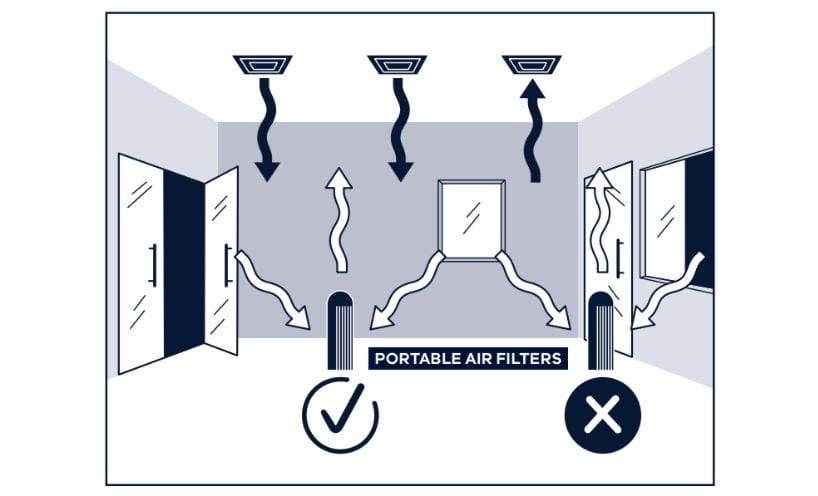Follow this simple guide to help purchase the best purifier for your home.

Get the right size purifier
Air purifier products are commonly differentiated by their Clean Air Delivery Rate (CADR). CADR is an established standard that describes how quickly an air purifier can clean the air in your room.
The larger the room size, the higher the CADR number required.
To work out the CADR number for your home, first measure the size of your room, then use the simple table below. Room calculations are based on a standard ceiling height of 2.4 metres and up to five people in the room at any given time.
Keep in mind the CADR calculated for your room and look for this information on product packaging when ready to purchase your air purifier products.
Room size
Minimum clean airflow Length (m) Width (m) Area (m2) CADR (cubic metres/hour) 2 2 4 48 3 3 9 108 4 4 16 192 4.5 4.5 20 243 5 5 25 300 5.5 5.5 30 363 6 6 36 432 7 7 49 588 
Make sure your purifier has a HEPA filter with a grade of at least H13
Filters have different grades based on their efficiency – the higher the number, the more efficient the filter is. You can find information about an air purifier’s filter grade on the product’s packaging or the website where the product’s specification is displayed.
Air purifiers with a High Efficiency Particulate Air (HEPA) filter, a recognised international standard, should be the preferred choice for filtering airborne viruses, bacteria, allergens, and other particles such as dust and smoke.
H13 filter grades or higher remove ≥99.9% of particles sized larger than 0.3 microns. Particles larger than 0.3 microns include pollen, dust, mould spores, smoke and bacteria. These filters are considered effective in reducing the risk of infection spread through the air. You can find the filter’s grade on the air purifier’s box or on the product’s specification website.
Some air purifiers have a higher ongoing cost if they require more frequent filter replacement or are less energy efficient. Replacing filters with lower quality options or forgetting to clean the filter can also decrease the effectiveness of your air purifier. Always follow the manufacturer’s recommendations for cleaning and replacing air purifier filters.

Choose an air purifier with the right noise level for you
Noise levels are measured in 'decibels'. A whisper is about 30 decibels (dB), normal conversation is about 60 dB, and a motorcycle engine running is about 95 dB.
Each air purifier operates at a different noise level depending on its fan level. The noise levels of each product can be found on the box or on the product’s specification website.
If you prefer a quieter air purifier, then you may choose to have two quieter air purifiers instead of one larger unit.
Maximum recommended air purifier noise level (dB) for different environments:1
Environment dB Quiet for sleeping at night 35-40 Quiet areas (a quiet restaurant, classroom or office) 40-45 Loud office and childcare 40-50 Noisy environment (a café or gym) >50 Loud environments >60
Healthy home tips - what to avoid2
- Fans that blow air from person to person without filtration: Regular fans that don’t use a filtration system can spread viral particles around your room and increase the risk of air borne disease transmission.
- Air disinfection or air fresheners: These types of products can introduce chemicals to the air and may trigger asthma and irritation.
- Air purifiers that use ionisers, plasma, ozone and UV technology: In some cases, unproven technologies may be dangerous.
Healthy home tips - other things to consider
This page is intended to give guidance about air purifiers used in the home. More detailed information about the benefits of ventilation, and air purifiers in the workplace is provided on the Coronavirus Victoria and Department of Health websites.
Put the air purifier in the right place
Placing the air purifier according to the guidance below and the manufacturer’s instructions will ensure you are maximising airflow in the room.
Air purifier placement
- Make sure you know where the air intake is located on the unit. Most units draw air in from the front, so place them near a wall or in a corner where the air intake faces away from the wall to avoid obstruction.
- Make sure there is a small amount of space around the sides and back of the unit.
- Position the unit away from open doors and windows.
- The unit should be in an area of a room that isn’t used, such as the corner of a room and away from windows and doors.
- If there is an existing ventilation system in the building, if possible, place the unit near supply grilles to circulate filtered air.
Ventilation
Take the right steps for large gatherings (family and friends) or intense activity (for example, aerobic exercise).
It may be too expensive to consider additional or larger purifiers to address situations where there are larger than normal indoor gatherings or when there is intense activity. Instead, try to keep rooms well-ventilated. Ventilation can significantly improve indoor air quality.
How to create a well-ventilated space?
Ask yourself:
- Can you see open doors and windows?
- Are fans on, or can you feel air movement from air conditioning vents?
- Is there an air purifier switched on in the room?
Natural ventilation
Bringing outdoor air into your home is the most effective way to ventilate your home. If it is safe, open doors and windows to bring outdoor air in.
Opening windows and doors may not be the most practical during colder months – when practical, opening a window or two for 10 minutes each hour or when a room is empty will greatly improve the natural ventilation in your home.
Mechanical ventilation
You can use existing heating and cooling systems to help circulate air in your home and reduce the concentration of harmful particles. Most heating and cooling systems require periodic opening of windows and doors to allow fresh outdoor air into rooms. These systems can help circulate outside air into your home:
- split system air conditioners
- evaporative cooling and ducted systems
- fans.
References
- World Health Organisation (2010) ‘Noise (who.int)’, Robyn Schofield, University of Melbourne ‘Air cleaner guide frequently asked questions (unimelb.edu.au)’ and Pieter Peach, ‘Air Filters - Clean Air Stars (cleanairstars.com/filters)’, all accessed 30 April 2023.
- Robyn Schofield, University of Melbourne ‘Guide to air cleaners (unimelb.edu.au)’ and Victorian Department of Health, ‘COVID-19: Ventilation principles and strategies to reduce aerosol transmission in community and workplace settings (health.vic.gov.au), both accessed 30 April 2023.
Updated
